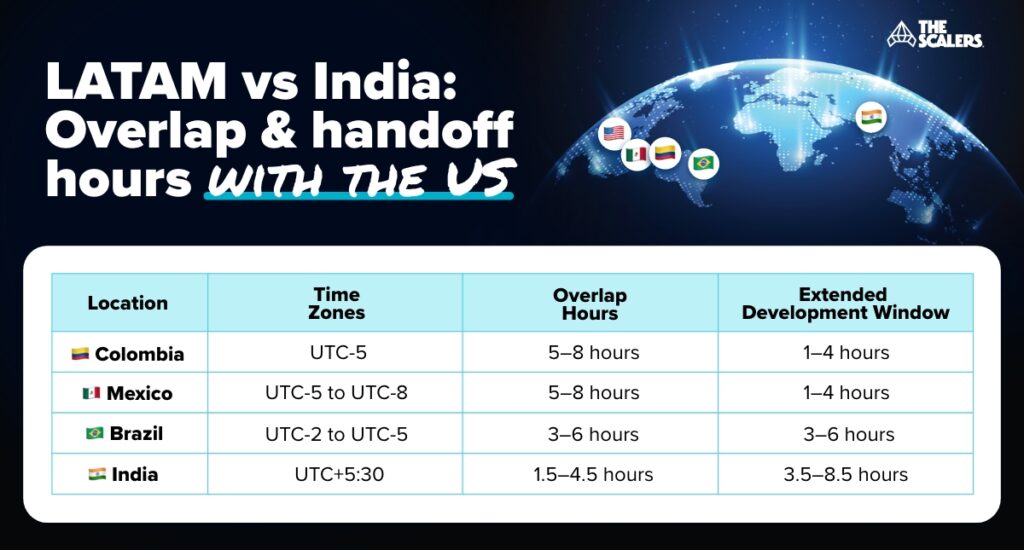On paper, cities like Mexico City, São Paulo, and Medellín couldn’t feel further from Bangalore, Pune, or Hyderabad. Nearly 10,000 miles apart, different continents, different time zones, different cultures, they share one thing in common: a love for tasty, spicy food!
But for US tech leaders, there’s another connection: both regions are top destinations for building and scaling engineering teams.
In our latest report, we compare LATAM and India using recent data to provide US CTOs with a clear view of where they should set up or extend their teams, depending on their specific needs. You can download the report for free today.
How LATAM and India compare across key parameters
Between 2019 and 2024, US multinationals increased their offshore hiring by 32%, almost twice the rate of domestic hiring (16.7%). This trend has also been visible among mid-sized companies and even startups, with LATAM and India emerging as the top offshore locations.
CTOs who opt to hire LATAM talent benefit from real-time collaboration, given the closer time zones, while those who prefer India access deep expertise and the ability to scale faster, thanks to its massive talent pool.

Below are the key parameters we analysed in comparing the two regions.
Talent pool size and depth
India has a larger talent pool with 5.8 million software engineers compared to LATAM’s ~2 million, split across multiple countries. India also produces more engineering graduates annually (1.5 million vs. ~200,000) and has a much bigger GitHub community.
Technical capabilities
Both regions excel in in-demand programming languages. India is more mature in AI, ML, and cloud computing, boasting the second-largest AI/ML talent pool globally. LATAM is an emerging market with potential for nearshore talent.
Python, JavaScript, and Rust are among the most in-demand programming languages in the US today, and both India and LATAM have the technical talent to help bridge the gap. For instance, LATAM is home to an estimated 400,000 to 600,000 Python engineers, while India offers a far larger pool, ranging from 1.5 to 2 million Python professionals.

Cost efficiency
LATAM and India offer cost-effective operations compared to the US. India has lower median salaries for mid-level software engineers ($18-$35/hour) compared to LATAM countries like Mexico ($30-$50/hour), Colombia ($25-$45/hour), and Brazil ($20-$40/hour).
Time zone and collaboration
LATAM has excellent time zone overlap with the US, facilitating real-time collaboration. India has limited overlap, but this can be leveraged for extended development coverage through handoff hours.

Language, culture, and communication
English proficiency is higher in India than in Colombia, Brazil, and Mexico, according to the EF English Proficiency Index. LATAM engineers possess solid language skills, though English levels vary from one country to another.
Scalability and tech ecosystem maturity
India has a well-established and mature tech ecosystem, supported by the government and featuring R&D centers from global tech companies and home to over 100 unicorn startups. LATAM is an emerging market, with Brazil and Mexico as key nearshore markets, but it faces structural challenges.
Get the report and find out what location best fits your business needs and goals
‘LATAM vs India’ report is for you if you’re a US business leader undecided on where to build or extend your tech team.
What’s inside?
- A comparison of how India and LATAM perform across 8 key metrics like talent pool size, specialisation, tech ecosystem maturity, and cost-efficiency.
- A data-driven overview of which country leads in AI, ML, cloud, and full-stack development, and where you’ll find deeper talent in languages like Python and JavaScript.
- Guidance on what to consider based on your company’s goals and overall roadmap to pick the best location for you.
Download your free copy and get the data you need to make an informed decision.
Build Your Team,
Not Just a Contract
With The Scalers’ offshore dedicated development team, you get engineers who join your workflow for the long run. Grow steadily, stay flexible, and work with people who care about the product as much as you do.








